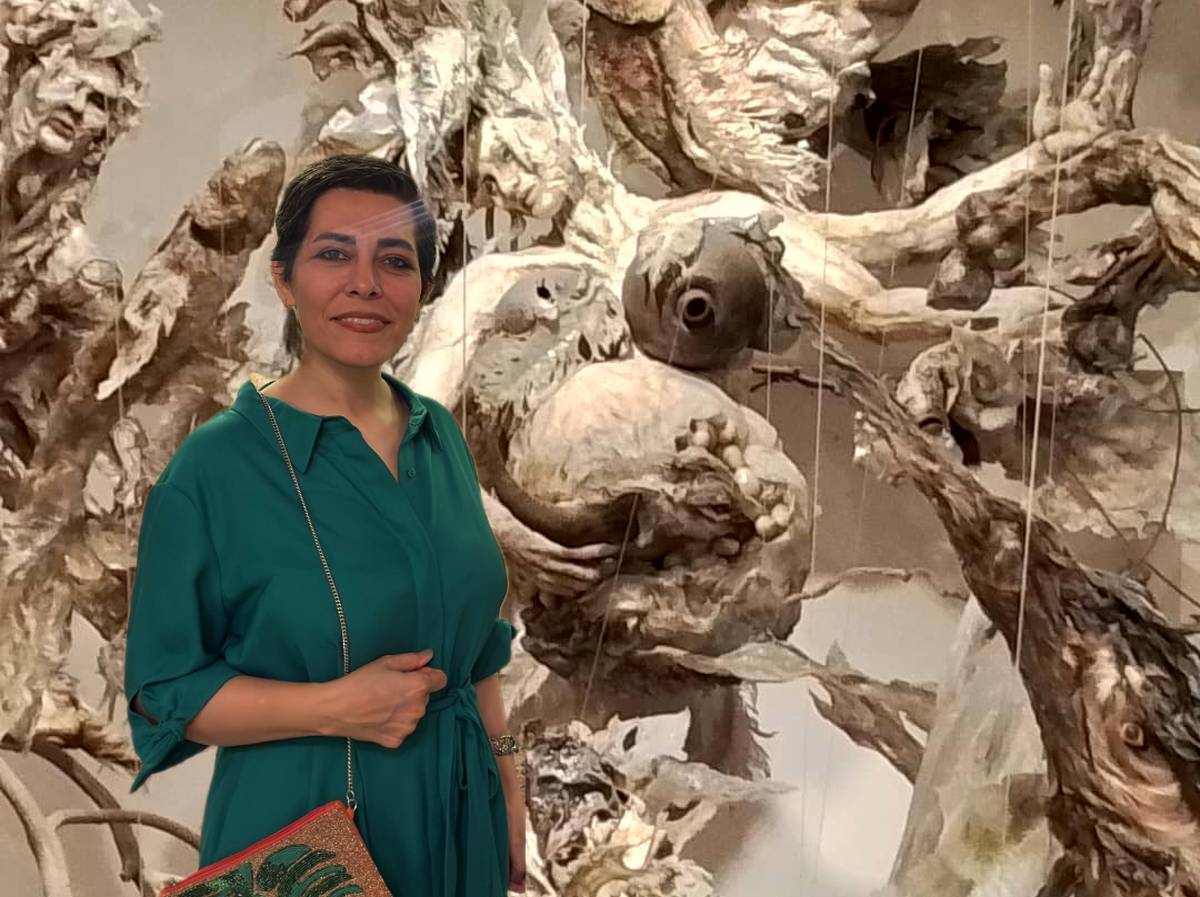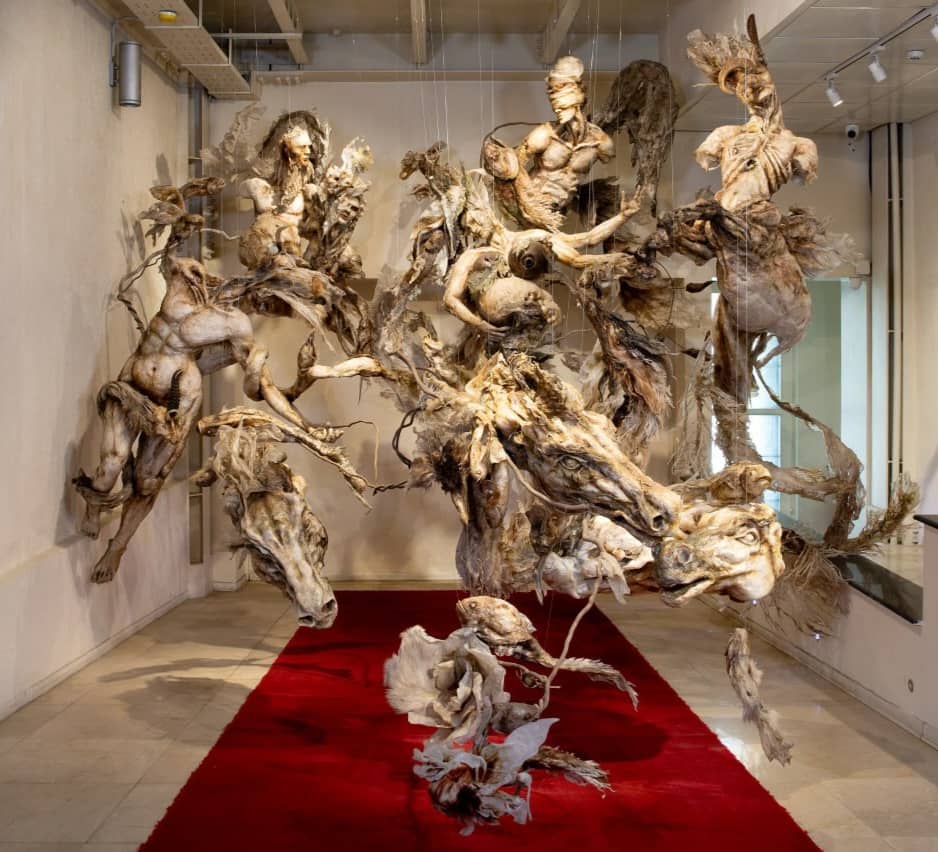
Ahura Mazda in Bundahishn by Elham Fallahi: A Symbolic Birth from Recycled Materials in the Raha Gallery Collection
The sculpture Ahura Mazda, at the heart of Elham Fallahi’s monumental installation Bundahishn, is not merely one among its 82 sculptures but the conceptual, visual, and philosophical core of the work—the point where chaos and waste are transfigured into creation and meaning.
ArtDayMe – The Raha Gallery Middle East Collection, Founded and directed by engineer Mohammadreza Ghaemmaghami, has been actively committed to cultural engagement in the region for over two decades. The collection preserves a rich array of modern and contemporary masterpieces by both Iranian and Arab artists.

Among them is Elham Fallahi’s large-scale installation Bundahishn, a six-by-six-by-four-meter work created in 2019 with the support of Raha Gallery Middle East Collection. Constructed with recycled and discarded materials—particularly plastic—this piece includes six monumental figures, 76 smaller sculptures, and connective components. Fallahi dedicated two years and six months to its creation.
One of the six large figures is Ahura Mazda, positioned at the central axis of the installation. This essay focuses on that figure:

At the heart of the monumental Bundahishn installation in Raha Gallery stands a striking sculpture—Ahura Mazda by Elham Fallahi. Shaped as a pregnant woman with multiple arms reminiscent of Shiva, the figure is not only the visual center but also the conceptual and philosophical core of the work.
Endless Creation
The organic, intertwined form, with outstretched arms, creates a swirling, fluid rhythm. The pregnant body anchors the center, while the arms extend like branches into space, suggesting an infinite act of creation. After wandering among monstrous heads and animal forms, the viewer’s gaze inevitably returns to this figure.
Birth from Waste
A defining feature of Ahura Mazda and the entire Bundahishn is the use of discarded materials, especially plastic. This choice lends the sculpture a fleshy, weathered quality while carrying a powerful conceptual charge: creation born from the refuse of contemporary consumerism. The juxtaposition of a divine subject with such base, valueless material raises profound questions about value and worth in today’s world.

Dualities of Beginning and End
In this work, Ahura Mazda symbolizes Mother Earth—fertility and creation embodied in feminine form. Its many arms, like Shiva’s, signify simultaneous power, creation, and destruction. Within one being, opposites converge: light and darkness, beginning and end, protection and ruin. Against the chaotic, violent creatures surrounding it, this figure becomes the axis of balance and creation.
The Gravitational Center of Bundahishn
This sculpture is not passive but commands the space. Its expansive arms and spiraling forms invade the environment, drawing the viewer in. Thus, Ahura Mazda becomes the gravitational center of Bundahishn, just as the sun anchors the solar system.

Environmental Art
By working with waste and plastic, Fallahi aligns her art with global eco-art movements that have become increasingly urgent in recent years. In a world facing its most perilous environmental moment, art of this kind may awaken societies to awareness and perhaps even contribute to survival. Yet Fallahi’s language is unique: by fusing recycled matter with Persian and Eastern mythologies, she creates a dialogue between tradition and contemporaneity, myth and ecological crisis.
Ahura Mazda in Feminine Form
In Iranian culture, Ahura Mazda is the creator of goodness and light. Here, Fallahi envisions this deity in a pregnant, feminine body—an image simultaneously invoking fertility myths and the archetype of Mother Earth. Yet when this creator is constructed from garbage, the work critically reflects on the crisis of our world: even within waste and consumerist chaos, life and creation endure.

The Conceptual and Visual Core
Ahura Mazda encapsulates multiple layers:
• Formally, it is organic and dynamic.
• Materially, it embodies creation from waste.
• Conceptually, it unites dualities of beginning and end, birth and destruction.
• Culturally, it bridges Persian mythology with contemporary critique.
Thus, Ahura Mazda is not just one sculpture among many in Bundahishn—it is the work’s conceptual, visual, and philosophical nucleus, the point where waste and chaos are transformed into meaning and creation.

The Market for Elham Fallahi’s Works
Elham Fallahi’s works are held in prominent collections across the United States, Europe, and Iran, including Raha Gallery (Iran–Dubai), the Mortezavi Foundation (Iran–USA), Didi Museum Gallery (Iran), Oak Tree Collection at the Levy Collection (USA), City Pak Collection (USA), Marmar Gallery (USA), Rira Gallery (Dubai), and numerous private collections in Iran, France, Australia, Canada, the US, and China.
Her market has seen remarkable growth: small works, such as a life-sized rose, have sold for around $2,500, while large multi-figure installations have reached $240,000 in sales through her studio, galleries, and expos. Her works have appeared twice at auction: in December 2019, The Battle of Rakhsh and Homay (2017, 120×100×150 cm, recycled materials) sold at Tehran Auction for four times its base price—240 million tomans (approx. $22,000 at the time). In 2021, a smaller work, Horse Bust (50×40×30 cm), sold for $10,000 at MAP Auction in the US.
The Bundahishn installation has attracted significant attention from the art community, with museums and biennials expressing strong interest in exhibiting it.

the work belongs to the Raha Gallery Middle East Collection.

LEAVE A RELPY